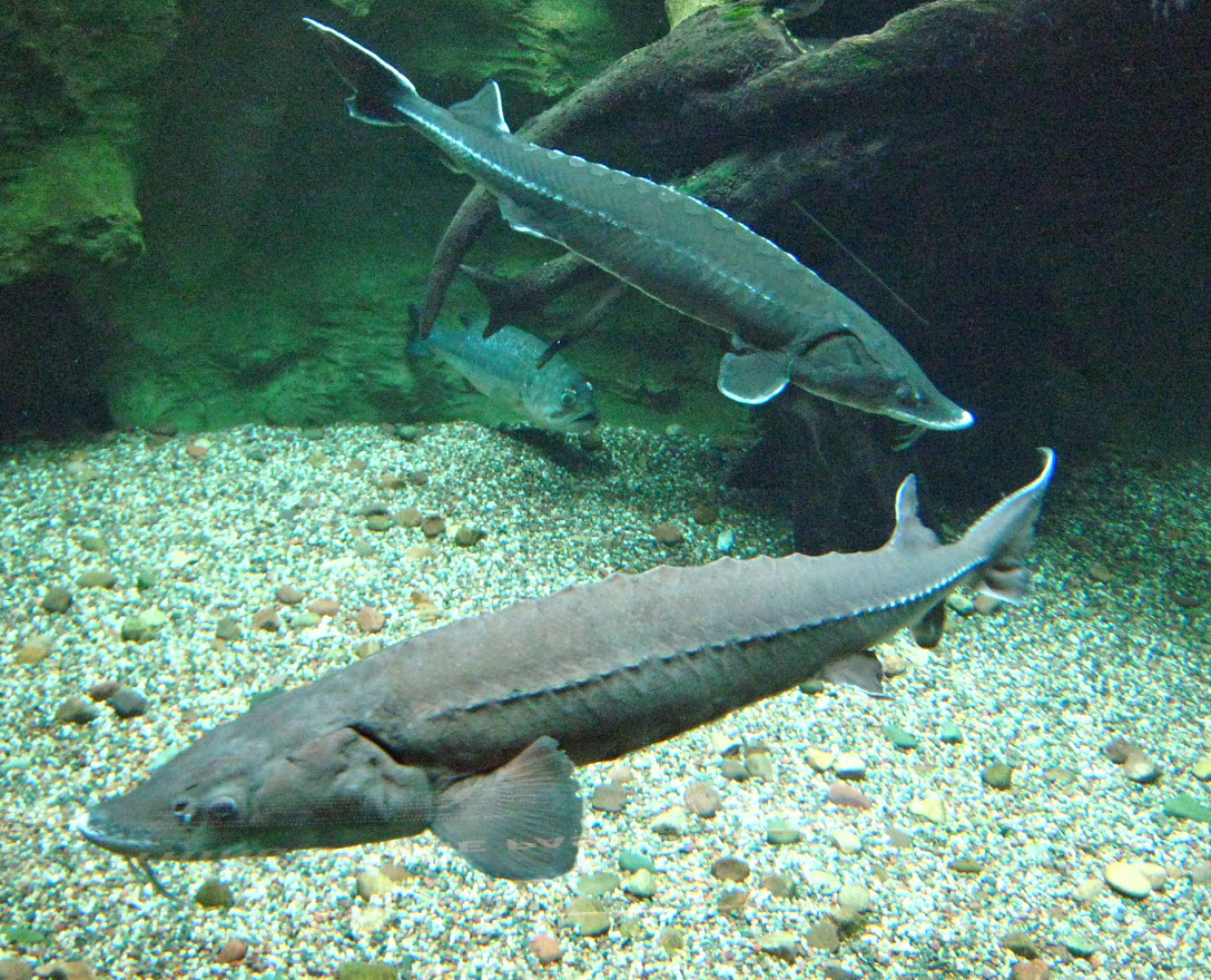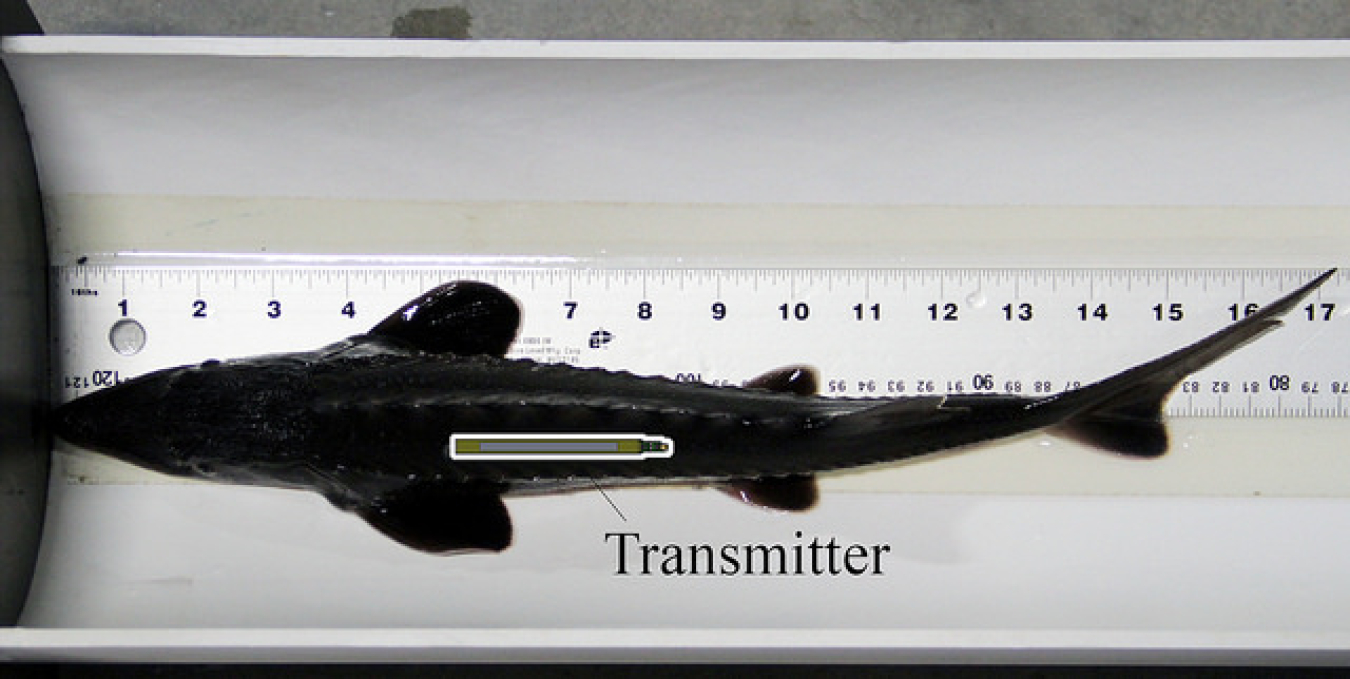
PNNL's self-powered acoustic fish-tracking tag is designed to track long-living fish such as sturgeon (shown here) throughout the course of their lives.
Courtesy of swimfinfan/Flickr

PNNL implanted its self-powered tracking tag into a juvenile sturgeon (shown here) and a rainbow trout, representing the first time a piezoelectric device was powered by a live fish. The surgery went so fast that researchers didn’t have time to take a picture of the event. Shown here is an artist’s representation of where the tag was implanted in the sturgeon (credit PNNL)>

PNNL’s self-powered fish-tracking tag comes in two lengths to accommodate differently sized fish: 100 and 77 millimeters, or about 11 to 14 grains of long rice placed head-to-head (credit PNNL).

A computer drawing of PNNL’s self-powered fish-tracking tag displays the device’s three components: a flexible piezoelectric strip (right), a circuit board and a beeping transducer (left). Credit PNNL.
News release from Pacific Northwest National Laboratory
RICHLAND, Wash. – With each swish of a tail, scientists now have a tool that could study the movements of fish throughout their entire lives.
The Department of Energy's Pacific Northwest National Laboratory developed a self-charging tracking tag for fish behavioral studies. This new tag uses a flexible strip containing piezoelectric materials, which generate electricity through physical movement. The tags emit tiny beeps that are recorded by underwater receivers and are designed to track many different species of fish including long-living fish such as sturgeon and migratory species of concern such as eel and lamprey. It is described in the journal Scientific Reports.
"Our self-powered acoustic tag can help us better understand how dams and ocean energy devices affect fish behavior," said the paper's corresponding author, PNNL chief scientist Zhiqun "Daniel" Deng. "Sturgeon are ancient fish and have been on this planet for millions of years. This tag can help us mitigate the impacts of human activities, and help these fish survive many more years."
A tag's ability to power itself is the latest upgrade to the Juvenile Salmon Acoustic Telemetry System, which PNNL has continuously developed since 2001 to evaluate how fish move near hydroelectric dams and other water structures. Researchers gradually made the system's tag smaller and more energy efficient, but it could only beep as long as the tiny battery inside it produced power. The tag's previous version typically lasts about 100 days. Now, the new tag is designed to work as long as the fish carrying it swims.
Piezoelectricity is a hot area of research, with the self-charging materials being used to harvest energy from everything from insects to human joints. Deng and his team believe their tag is the first device to be powered by live fish.
PNNL's self-powered fish tag has three parts: a piezoelectric composite strip, a circuit board and a beeping transducer. The tag comes in two lengths to accommodate differently sized fish: 100 and 77 millimeters, making the total length of the tag about 11 to 14 grains of long rice placed head-to-head. The longer variety weighs about the same as a paperclip, or 1.05 grams, while the shorter one weighs 0.80 grams.
Deng and his team initially tested the concept in the lab with a robotic fish tail. Next, the scientists tried it out in two live fish, a white sturgeon and a rainbow trout. They surgically inserted a tag just under skin near each fish's rear dorsal fins. The team watched the tagged fish swim in circular tanks equipped with underwater microphones, which picked up the tags' telltale beeps for the full two weeks the fish were observed. The tag did not appear to hinder either fish's swimming ability.
PNNL will test the self-powered tag outside of the lab for the first time next year. Tagged white sturgeon will be studied along the Columbia and Snake rivers in Washington state. The field research is being supported by DOE's Office of Technology Transitions in collaboration with industry partners.
Future development could also include determining the tag's optimal placement inside different fish species, which sizes of fish can be implanted with the device, and determining how the tag operates under high pressures.
The self-powered tag's initial development was supported with internal PNNL funding and DOE's Office of Energy Efficiency & Renewable Energy.
This week's paper describes a self-powered tag that charges a capacitor as the fish moves, and can only beep if the fish is moving. But Deng and his team have also developed another version with a small battery, which enables such a tag to beep more regularly and even if a fish is resting.
Those interested in partnering with PNNL or licensing opportunities related to this technology can contact PNNL Commercialization Manager Sara Hunt.
REFERENCE: Huidong Li, Chuan Tian, Jun Lu, Mitchell Myjak, Jayson Martinez, Richard Brown & Z. Daniel Deng, "An Energy Harvesting Underwater Acoustic Transmitter for Aquatic Animals," Scientific Reports, Sept. 20, 2016, DOI:10.1038/srep33804.
Tags: Energy, Environment, Fundamental Science, Hydropower, Green Energy, Marine Research, Biology, Fish
Interdisciplinary teams at Pacific Northwest National Laboratory address many of America's most pressing issues in energy, the environment and national security through advances in basic and applied science. Founded in 1965, PNNL employs 4,400 staff and has an annual budget of nearly $1 billion. It is managed by Battelle for the U.S. Department of Energy's Office of Science. As the single largest supporter of basic research in the physical sciences in the United States, the Office of Science is working to address some of the most pressing challenges of our time.
